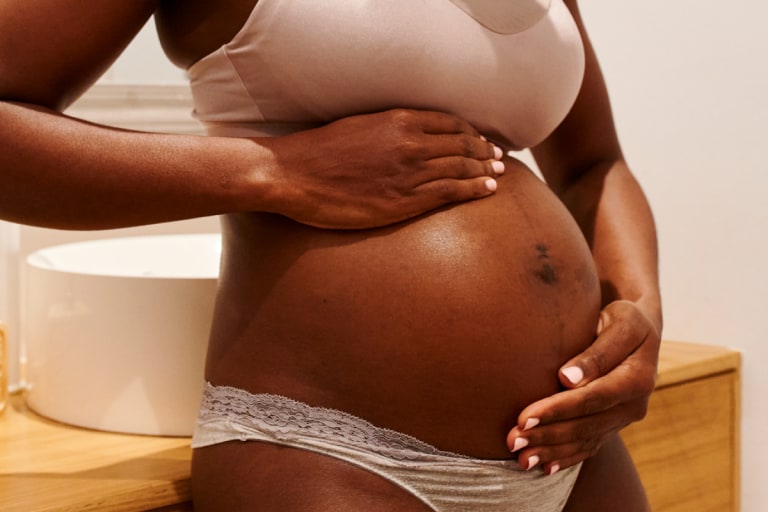
Five Pregnancy Symptoms Explained
Erica Chidi of LOOM makes sense of common changes during pregnancy, like nausea, back pain and swelling.

By Erica Chidi
Women are rarely taught how to understand their pregnant bodies. I worked as a doula for many years, and clients would come to me feeling confused and anxious about various pregnancy symptoms, whether a backache or swollen ankles. These symptoms were often common side-effects of growing a baby in your body. Typically, they were a sign that the pregnancy was progressing just as it should.
Our bodies talk to us in symptoms—we just need the right tools to understand. That’s why I co-founded the well-being startup LOOM and launched our online pregnancy and postpartum program, which helps you make sense of all of these changes in your body. It’s also why we created our Symptom Checker, the first empathetic, trauma-informed tool for women to learn about everything from anxiety to mood swings. (Think WebMD, but with feelings.) A symptom can be an opportunity for education and empowerment.
Granted, a backache is… a literal pain in the back. But it can also be a window into unseen bodily magic. So, let’s take a look inside.
Swelling During Pregnancy
During pregnancy, your blood volume increases 50 percent—and all that extra blood causes swelling. Plus, your growing uterus can interrupt the flow of blood, making fluid build up in your legs. Hormonal changes also make your body hold on to more water. In the second and third trimester, you might notice swelling in your feet and ankles, and your shoes might not fit so well anymore. (It’s a great time to break out the Crocs.)
Try wearing compression clothing—I recommend socks or leggings—for a couple hours a day. It gently squeezes your body, which can lower swelling and make you feel more contained and supported. The ancient Chinese healing technique of gua sha can also be supportive: A practitioner runs a smooth massage tool over your skin to improve circulation. Dry brushing—where you run a hard-bristled brush over your body—is a similar approach that you can easily try at home.
Keep in mind that swelling during pregnancy can be a sign of preeclampsia, a potentially dangerous condition. Reach out to your doctor if you’re concerned or have significant swelling, like not being able to wear your rings anymore.
Trouble Holding Your Pee During Pregnancy
As the uterus grows, it pushes up against the bladder, which rests just underneath it. This not only puts weight on the bladder, it also means less space for pee. That extra pressure makes your urethra—the tube you pee through—makes it harder to hold the urine in (it’s actually called “stress incontinence”). That’s not to mention the possibility of feeling little baby feet going pitter-patter on your bladder.
It’s no surprise, then, that pregnant folks often deal with pee-related problems—anything from a frequent need to go to the bathroom to an inability to hold your pee (a.k.a urinary incontinence). As with so many issues during pregnancy, it often gets better after giving birth, but if it doesn’t, consult a pelvic floor specialist.
Back Pain During Pregnancy
Back pain is super common in pregnancy. As your baby grows, the uterus pulls your body forward. This puts pressure on your sacrum, the triangle-shaped bone between your hips. Meanwhile, the pregnancy hormone relaxin makes your ligaments looser. This helps create space for your baby to grow, but it can add to your pain.
There are lots of things that might help—like walking, prenatal yoga and massage. Some folks find relief from a belly band, which wraps around the waist to support the lower back. Baths also are a powerful way to relax both mind and body, and they’re totally safe for you and your baby (just keep the temperature below 100°F).
After having your baby, you’ll probably notice your back pain getting better. So, for now, keep in mind: This pain is temporary.
Spotting During Pregnancy
Spotting is the kind of light vaginal bleeding that doesn’t require a pantyliner. It’s common in the first trimester: about 24 to 40% of pregnant folks have spotting early on.
It can be caused by everything from sex to a vaginal exam, thanks to the growth of blood vessels around the cervix during pregnancy. A hormonal shift around week six—specifically, a drop in progesterone—is another possible culprit. Spotting can also show up as a sign of implantation, a few weeks after fertilization, when the egg attaches to the lining of the uterus, which is called “implantation bleeding.”
Bleeding can be a sign of pregnancy loss, but roughly half of folks with early spotting do not end up having a miscarriage. That said, bleeding during any stage of pregnancy can be serious. Try not to worry—and keep those reassuring stats in mind—but it’s a great idea to check in with your doctor right away.
Sleepiness During Pregnancy
The first three months of pregnancy can be utterly exhausting. The amount of progesterone in your body is skyrocketing—and this hormone acts like nature’s sedative. If it’s any comfort, progesterone might be making you sleepy, but it’s also helping support your pregnancy.
There’s no getting around this hormonal reality. So, whenever you’re able, give yourself a nap instead of trying to power through feelings of sluggishness. At night, consider adopting a soothing bedtime routine—turn off all your devices, do a little gentle yoga, take a bath. It’s all about supporting your body through these wild changes—and knowing that so many of your pregnancy symptoms will disappear once you have your baby.